Management Accounting Report: Jeffrey & Sons Ltd Analysis
VerifiedAdded on 2020/01/21
|20
|4735
|64
Report
AI Summary
This Management Accounting report provides a comprehensive analysis of various cost concepts and their practical application within Jeffrey & Son’s Ltd. The report begins with a detailed description of cost classification, including direct and indirect costs, costs based on nature, and functional and behavioral costs. It then demonstrates the computation of job costs using job costing and exquisite costs through absorption costing. The report further includes the preparation and analysis of a cost report for September, highlighting variance analysis and the use of performance indicators to identify areas for improvement. The report also covers budgetary procedures, including the preparation of purchase, production, and cash budgets. Finally, the report concludes with a variance analysis and an operational reconciliation statement, offering recommendations for cost reduction and quality enhancement.
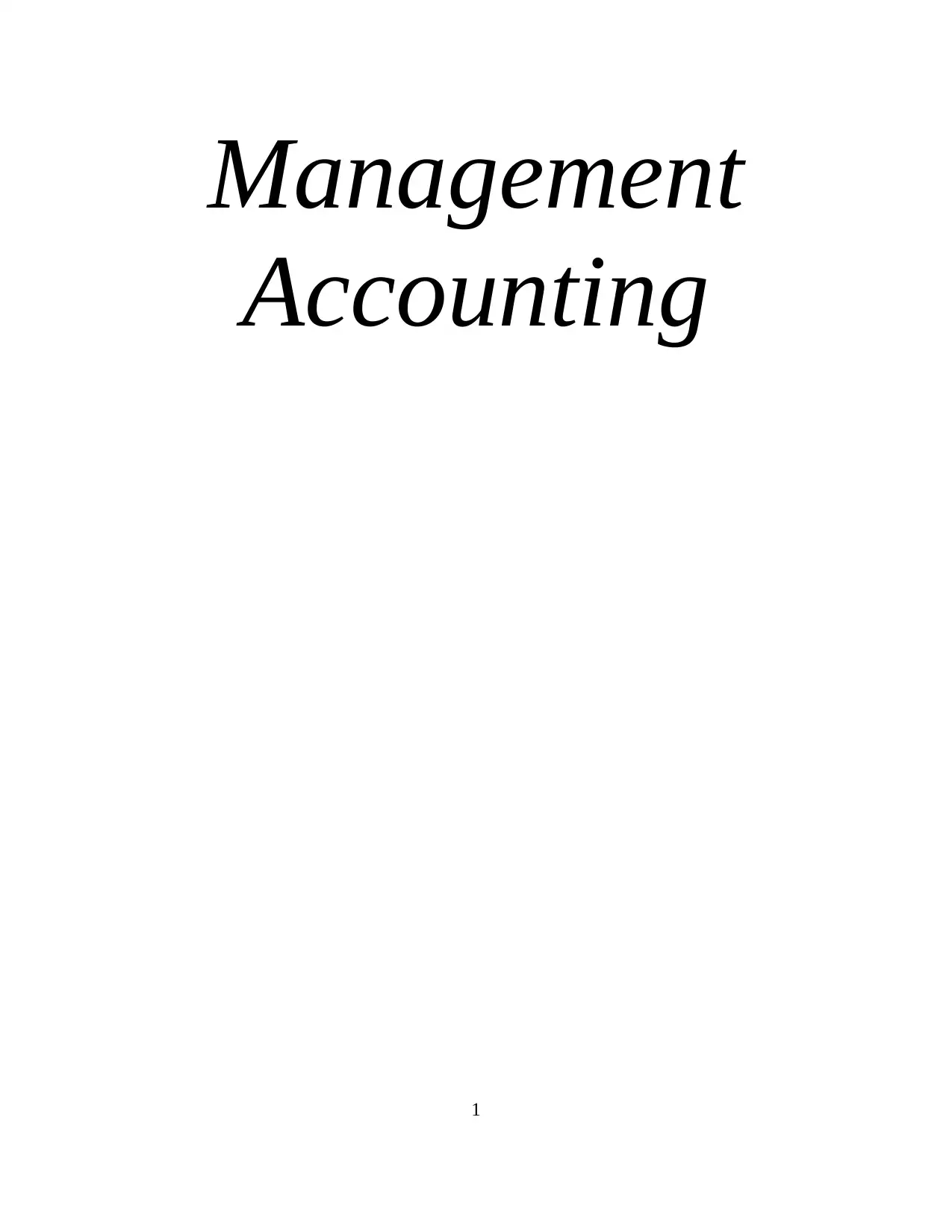
Management
Accounting
1
Accounting
1
Paraphrase This Document
Need a fresh take? Get an instant paraphrase of this document with our AI Paraphraser
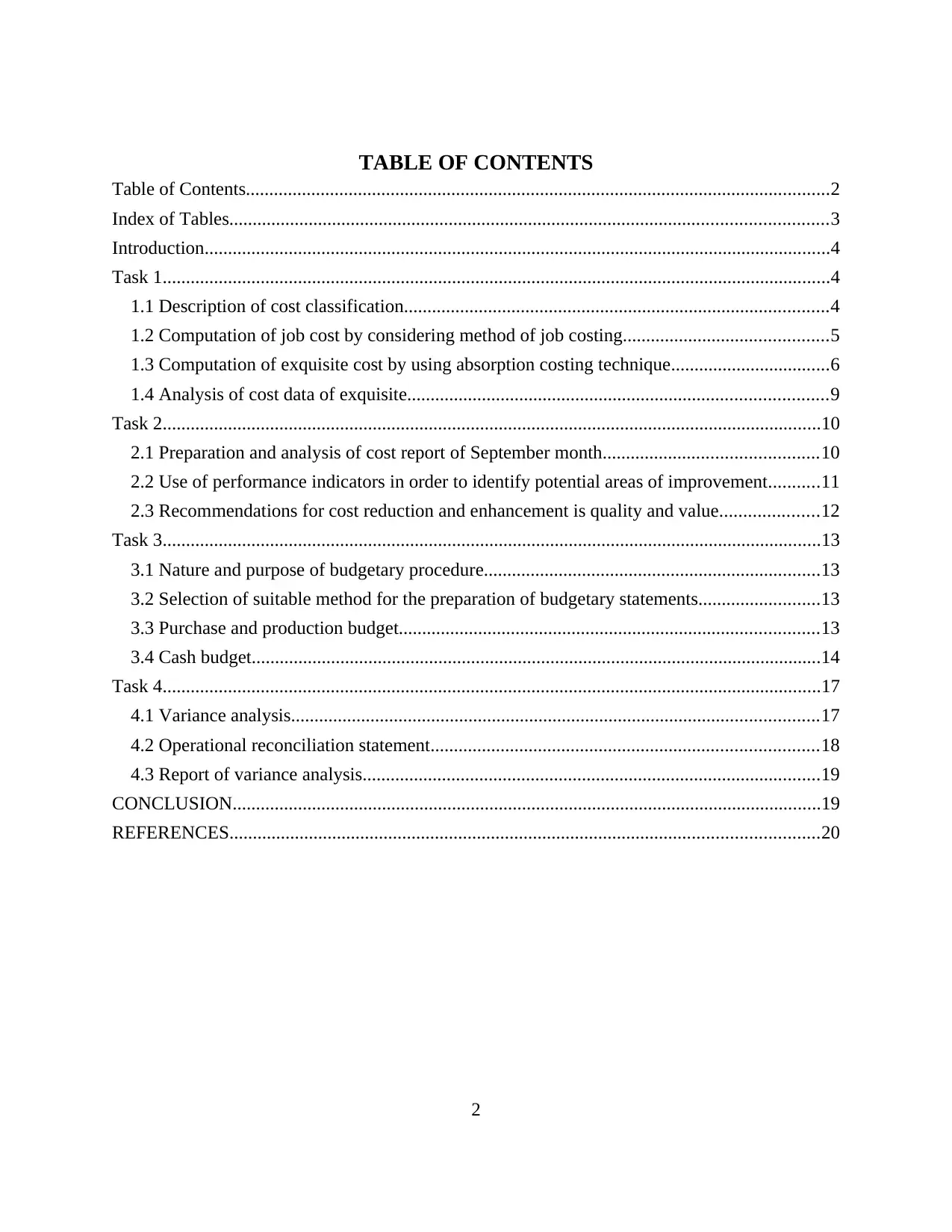
TABLE OF CONTENTS
Table of Contents.............................................................................................................................2
Index of Tables................................................................................................................................3
Introduction......................................................................................................................................4
Task 1...............................................................................................................................................4
1.1 Description of cost classification...........................................................................................4
1.2 Computation of job cost by considering method of job costing............................................5
1.3 Computation of exquisite cost by using absorption costing technique..................................6
1.4 Analysis of cost data of exquisite..........................................................................................9
Task 2.............................................................................................................................................10
2.1 Preparation and analysis of cost report of September month..............................................10
2.2 Use of performance indicators in order to identify potential areas of improvement...........11
2.3 Recommendations for cost reduction and enhancement is quality and value.....................12
Task 3.............................................................................................................................................13
3.1 Nature and purpose of budgetary procedure........................................................................13
3.2 Selection of suitable method for the preparation of budgetary statements..........................13
3.3 Purchase and production budget..........................................................................................13
3.4 Cash budget..........................................................................................................................14
Task 4.............................................................................................................................................17
4.1 Variance analysis.................................................................................................................17
4.2 Operational reconciliation statement...................................................................................18
4.3 Report of variance analysis..................................................................................................19
CONCLUSION..............................................................................................................................19
REFERENCES..............................................................................................................................20
2
Table of Contents.............................................................................................................................2
Index of Tables................................................................................................................................3
Introduction......................................................................................................................................4
Task 1...............................................................................................................................................4
1.1 Description of cost classification...........................................................................................4
1.2 Computation of job cost by considering method of job costing............................................5
1.3 Computation of exquisite cost by using absorption costing technique..................................6
1.4 Analysis of cost data of exquisite..........................................................................................9
Task 2.............................................................................................................................................10
2.1 Preparation and analysis of cost report of September month..............................................10
2.2 Use of performance indicators in order to identify potential areas of improvement...........11
2.3 Recommendations for cost reduction and enhancement is quality and value.....................12
Task 3.............................................................................................................................................13
3.1 Nature and purpose of budgetary procedure........................................................................13
3.2 Selection of suitable method for the preparation of budgetary statements..........................13
3.3 Purchase and production budget..........................................................................................13
3.4 Cash budget..........................................................................................................................14
Task 4.............................................................................................................................................17
4.1 Variance analysis.................................................................................................................17
4.2 Operational reconciliation statement...................................................................................18
4.3 Report of variance analysis..................................................................................................19
CONCLUSION..............................................................................................................................19
REFERENCES..............................................................................................................................20
2
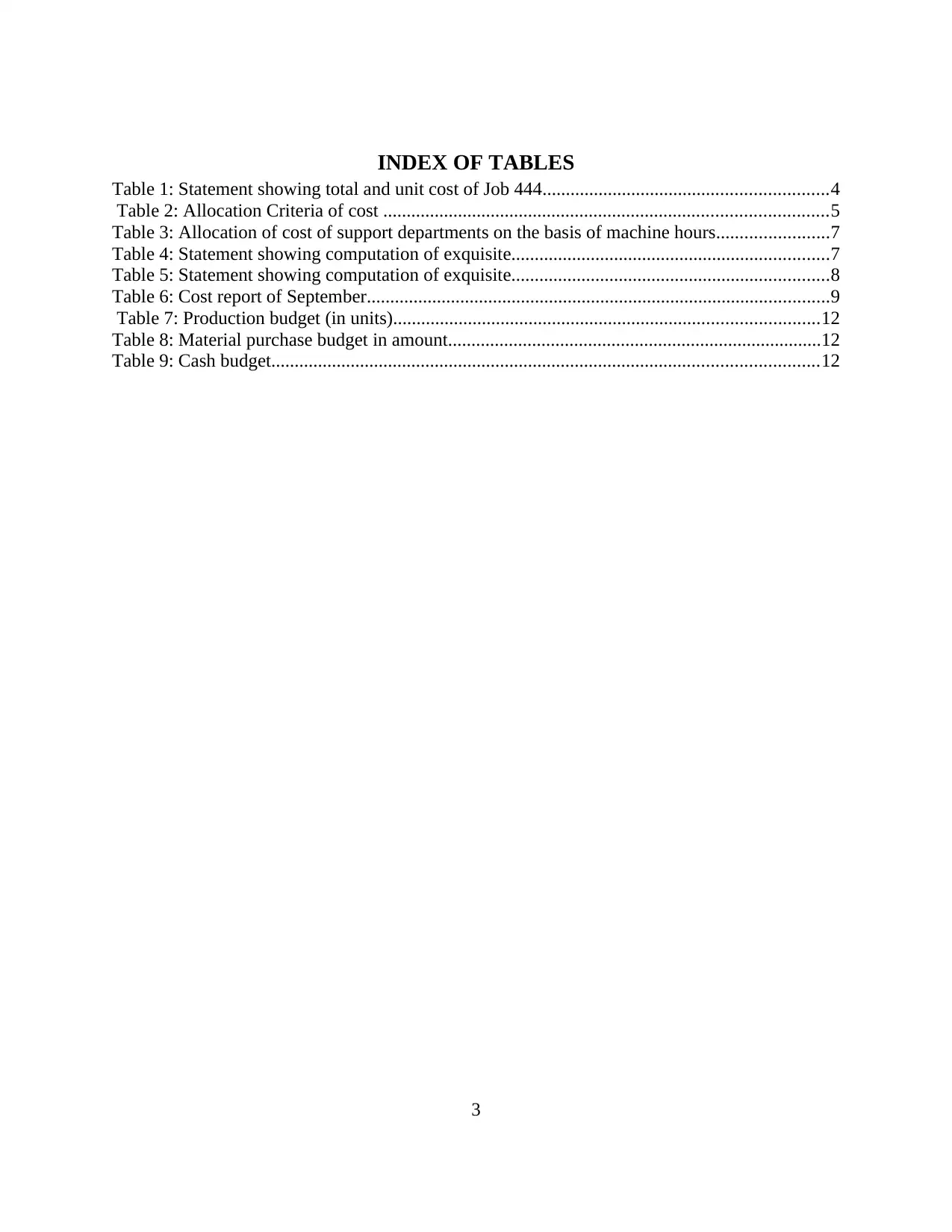
INDEX OF TABLES
Table 1: Statement showing total and unit cost of Job 444.............................................................4
Table 2: Allocation Criteria of cost ...............................................................................................5
Table 3: Allocation of cost of support departments on the basis of machine hours........................7
Table 4: Statement showing computation of exquisite....................................................................7
Table 5: Statement showing computation of exquisite....................................................................8
Table 6: Cost report of September...................................................................................................9
Table 7: Production budget (in units)...........................................................................................12
Table 8: Material purchase budget in amount................................................................................12
Table 9: Cash budget.....................................................................................................................12
3
Table 1: Statement showing total and unit cost of Job 444.............................................................4
Table 2: Allocation Criteria of cost ...............................................................................................5
Table 3: Allocation of cost of support departments on the basis of machine hours........................7
Table 4: Statement showing computation of exquisite....................................................................7
Table 5: Statement showing computation of exquisite....................................................................8
Table 6: Cost report of September...................................................................................................9
Table 7: Production budget (in units)...........................................................................................12
Table 8: Material purchase budget in amount................................................................................12
Table 9: Cash budget.....................................................................................................................12
3
⊘ This is a preview!⊘
Do you want full access?
Subscribe today to unlock all pages.

Trusted by 1+ million students worldwide
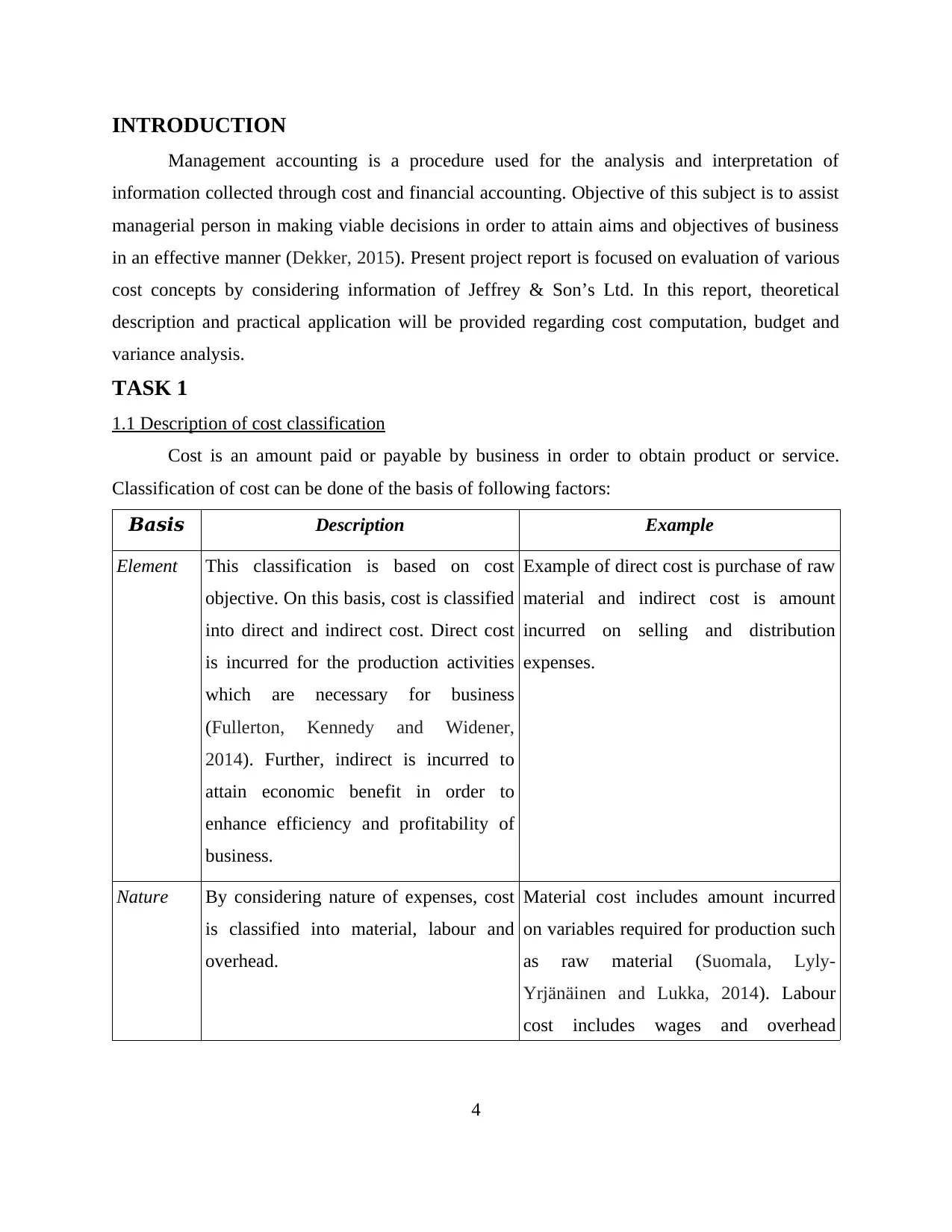
INTRODUCTION
Management accounting is a procedure used for the analysis and interpretation of
information collected through cost and financial accounting. Objective of this subject is to assist
managerial person in making viable decisions in order to attain aims and objectives of business
in an effective manner (Dekker, 2015). Present project report is focused on evaluation of various
cost concepts by considering information of Jeffrey & Son’s Ltd. In this report, theoretical
description and practical application will be provided regarding cost computation, budget and
variance analysis.
TASK 1
1.1 Description of cost classification
Cost is an amount paid or payable by business in order to obtain product or service.
Classification of cost can be done of the basis of following factors:
Basis Description Example
Element This classification is based on cost
objective. On this basis, cost is classified
into direct and indirect cost. Direct cost
is incurred for the production activities
which are necessary for business
(Fullerton, Kennedy and Widener,
2014). Further, indirect is incurred to
attain economic benefit in order to
enhance efficiency and profitability of
business.
Example of direct cost is purchase of raw
material and indirect cost is amount
incurred on selling and distribution
expenses.
Nature By considering nature of expenses, cost
is classified into material, labour and
overhead.
Material cost includes amount incurred
on variables required for production such
as raw material (Suomala, Lyly-
Yrjänäinen and Lukka, 2014). Labour
cost includes wages and overhead
4
Management accounting is a procedure used for the analysis and interpretation of
information collected through cost and financial accounting. Objective of this subject is to assist
managerial person in making viable decisions in order to attain aims and objectives of business
in an effective manner (Dekker, 2015). Present project report is focused on evaluation of various
cost concepts by considering information of Jeffrey & Son’s Ltd. In this report, theoretical
description and practical application will be provided regarding cost computation, budget and
variance analysis.
TASK 1
1.1 Description of cost classification
Cost is an amount paid or payable by business in order to obtain product or service.
Classification of cost can be done of the basis of following factors:
Basis Description Example
Element This classification is based on cost
objective. On this basis, cost is classified
into direct and indirect cost. Direct cost
is incurred for the production activities
which are necessary for business
(Fullerton, Kennedy and Widener,
2014). Further, indirect is incurred to
attain economic benefit in order to
enhance efficiency and profitability of
business.
Example of direct cost is purchase of raw
material and indirect cost is amount
incurred on selling and distribution
expenses.
Nature By considering nature of expenses, cost
is classified into material, labour and
overhead.
Material cost includes amount incurred
on variables required for production such
as raw material (Suomala, Lyly-
Yrjänäinen and Lukka, 2014). Labour
cost includes wages and overhead
4
Paraphrase This Document
Need a fresh take? Get an instant paraphrase of this document with our AI Paraphraser
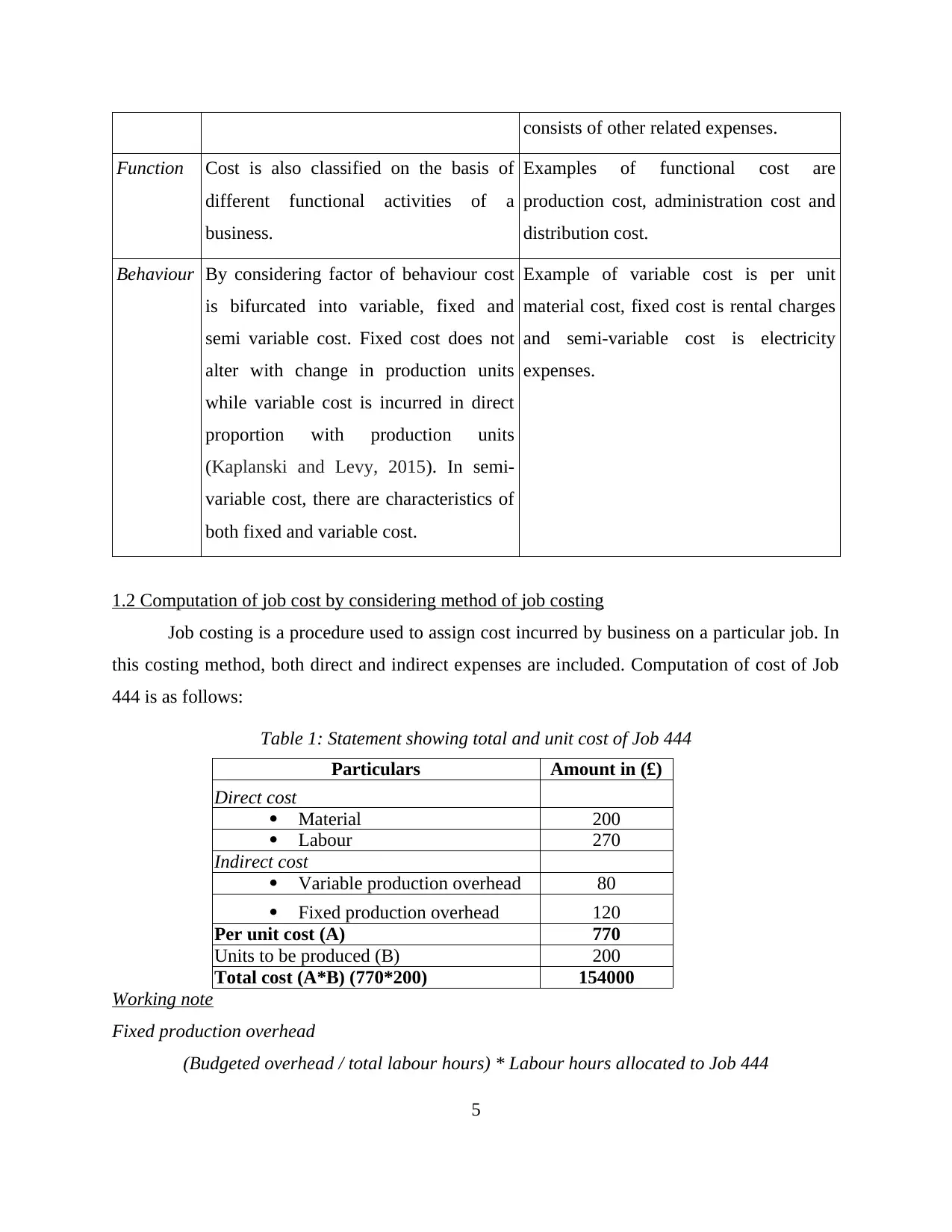
consists of other related expenses.
Function Cost is also classified on the basis of
different functional activities of a
business.
Examples of functional cost are
production cost, administration cost and
distribution cost.
Behaviour By considering factor of behaviour cost
is bifurcated into variable, fixed and
semi variable cost. Fixed cost does not
alter with change in production units
while variable cost is incurred in direct
proportion with production units
(Kaplanski and Levy, 2015). In semi-
variable cost, there are characteristics of
both fixed and variable cost.
Example of variable cost is per unit
material cost, fixed cost is rental charges
and semi-variable cost is electricity
expenses.
1.2 Computation of job cost by considering method of job costing
Job costing is a procedure used to assign cost incurred by business on a particular job. In
this costing method, both direct and indirect expenses are included. Computation of cost of Job
444 is as follows:
Table 1: Statement showing total and unit cost of Job 444
Particulars Amount in (£)
Direct cost
Material 200
Labour 270
Indirect cost
Variable production overhead 80
Fixed production overhead 120
Per unit cost (A) 770
Units to be produced (B) 200
Total cost (A*B) (770*200) 154000
Working note
Fixed production overhead
(Budgeted overhead / total labour hours) * Labour hours allocated to Job 444
5
Function Cost is also classified on the basis of
different functional activities of a
business.
Examples of functional cost are
production cost, administration cost and
distribution cost.
Behaviour By considering factor of behaviour cost
is bifurcated into variable, fixed and
semi variable cost. Fixed cost does not
alter with change in production units
while variable cost is incurred in direct
proportion with production units
(Kaplanski and Levy, 2015). In semi-
variable cost, there are characteristics of
both fixed and variable cost.
Example of variable cost is per unit
material cost, fixed cost is rental charges
and semi-variable cost is electricity
expenses.
1.2 Computation of job cost by considering method of job costing
Job costing is a procedure used to assign cost incurred by business on a particular job. In
this costing method, both direct and indirect expenses are included. Computation of cost of Job
444 is as follows:
Table 1: Statement showing total and unit cost of Job 444
Particulars Amount in (£)
Direct cost
Material 200
Labour 270
Indirect cost
Variable production overhead 80
Fixed production overhead 120
Per unit cost (A) 770
Units to be produced (B) 200
Total cost (A*B) (770*200) 154000
Working note
Fixed production overhead
(Budgeted overhead / total labour hours) * Labour hours allocated to Job 444
5
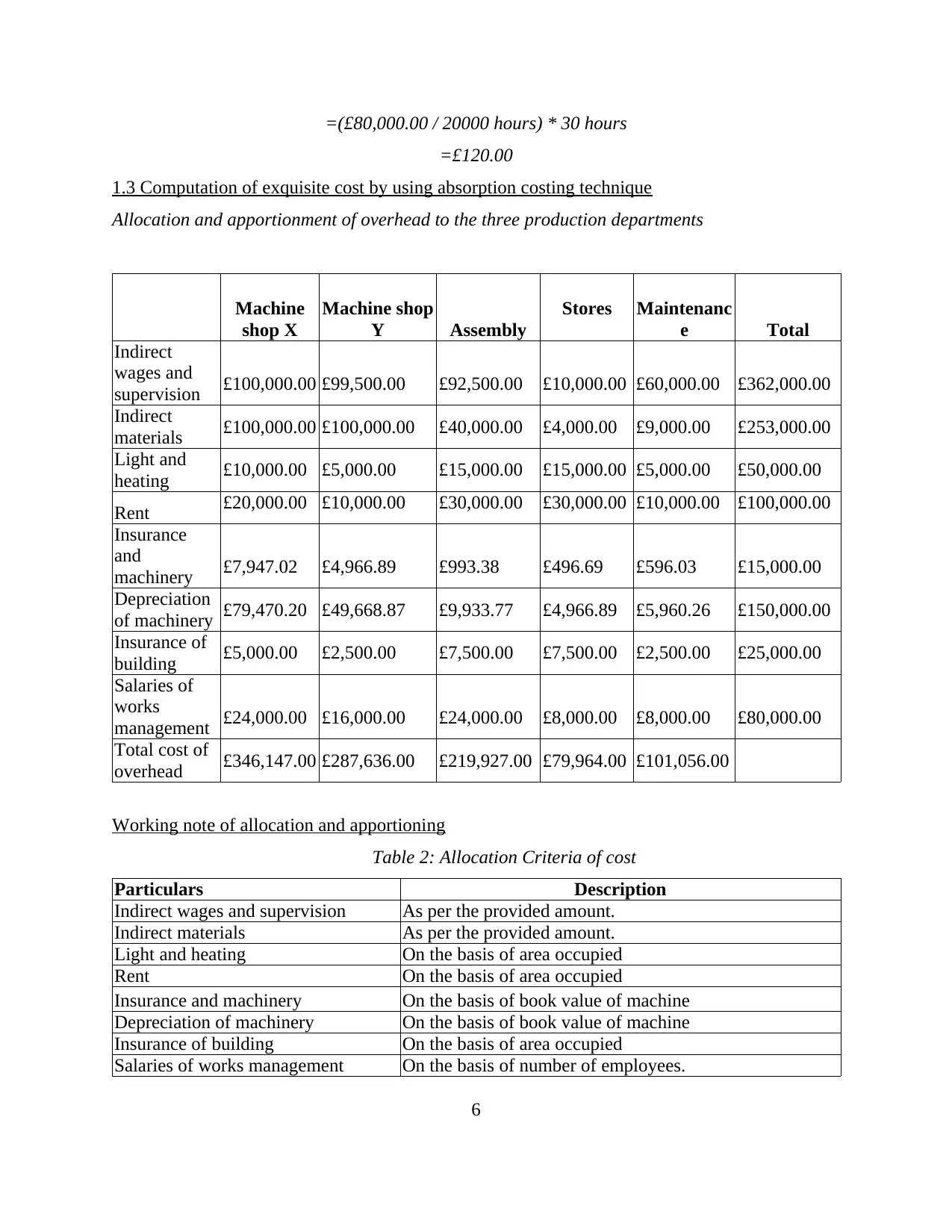
=(£80,000.00 / 20000 hours) * 30 hours
=£120.00
1.3 Computation of exquisite cost by using absorption costing technique
Allocation and apportionment of overhead to the three production departments
Machine
shop X
Machine shop
Y Assembly
Stores Maintenanc
e Total
Indirect
wages and
supervision £100,000.00 £99,500.00 £92,500.00 £10,000.00 £60,000.00 £362,000.00
Indirect
materials £100,000.00 £100,000.00 £40,000.00 £4,000.00 £9,000.00 £253,000.00
Light and
heating £10,000.00 £5,000.00 £15,000.00 £15,000.00 £5,000.00 £50,000.00
Rent £20,000.00 £10,000.00 £30,000.00 £30,000.00 £10,000.00 £100,000.00
Insurance
and
machinery £7,947.02 £4,966.89 £993.38 £496.69 £596.03 £15,000.00
Depreciation
of machinery £79,470.20 £49,668.87 £9,933.77 £4,966.89 £5,960.26 £150,000.00
Insurance of
building £5,000.00 £2,500.00 £7,500.00 £7,500.00 £2,500.00 £25,000.00
Salaries of
works
management £24,000.00 £16,000.00 £24,000.00 £8,000.00 £8,000.00 £80,000.00
Total cost of
overhead £346,147.00 £287,636.00 £219,927.00 £79,964.00 £101,056.00
Working note of allocation and apportioning
Table 2: Allocation Criteria of cost
Particulars Description
Indirect wages and supervision As per the provided amount.
Indirect materials As per the provided amount.
Light and heating On the basis of area occupied
Rent On the basis of area occupied
Insurance and machinery On the basis of book value of machine
Depreciation of machinery On the basis of book value of machine
Insurance of building On the basis of area occupied
Salaries of works management On the basis of number of employees.
6
=£120.00
1.3 Computation of exquisite cost by using absorption costing technique
Allocation and apportionment of overhead to the three production departments
Machine
shop X
Machine shop
Y Assembly
Stores Maintenanc
e Total
Indirect
wages and
supervision £100,000.00 £99,500.00 £92,500.00 £10,000.00 £60,000.00 £362,000.00
Indirect
materials £100,000.00 £100,000.00 £40,000.00 £4,000.00 £9,000.00 £253,000.00
Light and
heating £10,000.00 £5,000.00 £15,000.00 £15,000.00 £5,000.00 £50,000.00
Rent £20,000.00 £10,000.00 £30,000.00 £30,000.00 £10,000.00 £100,000.00
Insurance
and
machinery £7,947.02 £4,966.89 £993.38 £496.69 £596.03 £15,000.00
Depreciation
of machinery £79,470.20 £49,668.87 £9,933.77 £4,966.89 £5,960.26 £150,000.00
Insurance of
building £5,000.00 £2,500.00 £7,500.00 £7,500.00 £2,500.00 £25,000.00
Salaries of
works
management £24,000.00 £16,000.00 £24,000.00 £8,000.00 £8,000.00 £80,000.00
Total cost of
overhead £346,147.00 £287,636.00 £219,927.00 £79,964.00 £101,056.00
Working note of allocation and apportioning
Table 2: Allocation Criteria of cost
Particulars Description
Indirect wages and supervision As per the provided amount.
Indirect materials As per the provided amount.
Light and heating On the basis of area occupied
Rent On the basis of area occupied
Insurance and machinery On the basis of book value of machine
Depreciation of machinery On the basis of book value of machine
Insurance of building On the basis of area occupied
Salaries of works management On the basis of number of employees.
6
⊘ This is a preview!⊘
Do you want full access?
Subscribe today to unlock all pages.

Trusted by 1+ million students worldwide
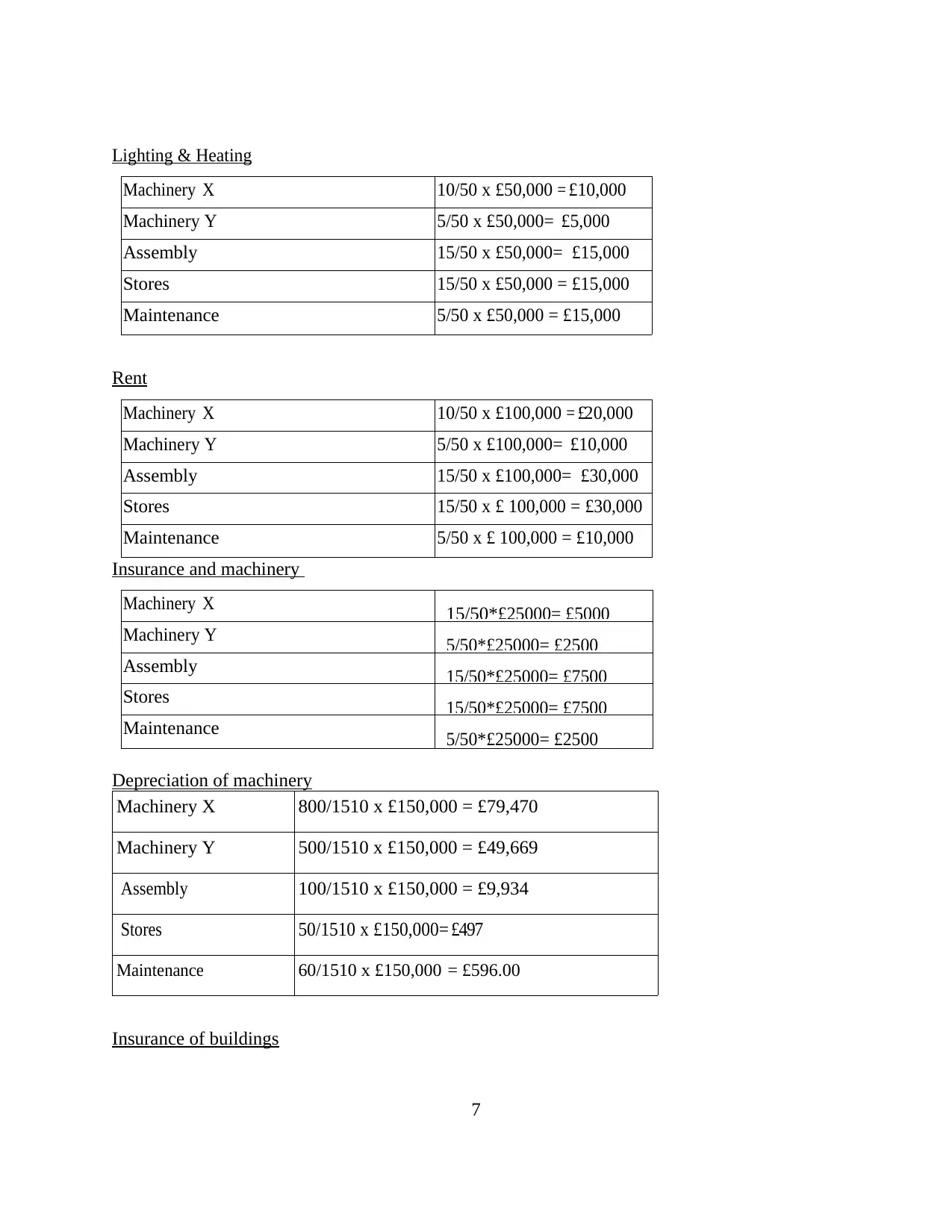
Lighting & Heating
Machinery X 10/50 x £50,000 = £10,000
Machinery Y 5/50 x £50,000= £5,000
Assembly 15/50 x £50,000= £15,000
Stores 15/50 x £50,000 = £15,000
Maintenance 5/50 x £50,000 = £15,000
Rent
Machinery X 10/50 x £100,000 = £20,000
Machinery Y 5/50 x £100,000= £10,000
Assembly 15/50 x £100,000= £30,000
Stores 15/50 x £ 100,000 = £30,000
Maintenance 5/50 x £ 100,000 = £10,000
Insurance and machinery
Machinery X 15/50*£25000= £5000
Machinery Y 5/50*£25000= £2500
Assembly 15/50*£25000= £7500
Stores 15/50*£25000= £7500
Maintenance 5/50*£25000= £2500
Depreciation of machinery
Machinery X 800/1510 x £150,000 = £79,470
Machinery Y 500/1510 x £150,000 = £49,669
Assembly 100/1510 x £150,000 = £9,934
Stores 50/1510 x £150,000= £497
Maintenance 60/1510 x £150,000 = £596.00
Insurance of buildings
7
Machinery X 10/50 x £50,000 = £10,000
Machinery Y 5/50 x £50,000= £5,000
Assembly 15/50 x £50,000= £15,000
Stores 15/50 x £50,000 = £15,000
Maintenance 5/50 x £50,000 = £15,000
Rent
Machinery X 10/50 x £100,000 = £20,000
Machinery Y 5/50 x £100,000= £10,000
Assembly 15/50 x £100,000= £30,000
Stores 15/50 x £ 100,000 = £30,000
Maintenance 5/50 x £ 100,000 = £10,000
Insurance and machinery
Machinery X 15/50*£25000= £5000
Machinery Y 5/50*£25000= £2500
Assembly 15/50*£25000= £7500
Stores 15/50*£25000= £7500
Maintenance 5/50*£25000= £2500
Depreciation of machinery
Machinery X 800/1510 x £150,000 = £79,470
Machinery Y 500/1510 x £150,000 = £49,669
Assembly 100/1510 x £150,000 = £9,934
Stores 50/1510 x £150,000= £497
Maintenance 60/1510 x £150,000 = £596.00
Insurance of buildings
7
Paraphrase This Document
Need a fresh take? Get an instant paraphrase of this document with our AI Paraphraser
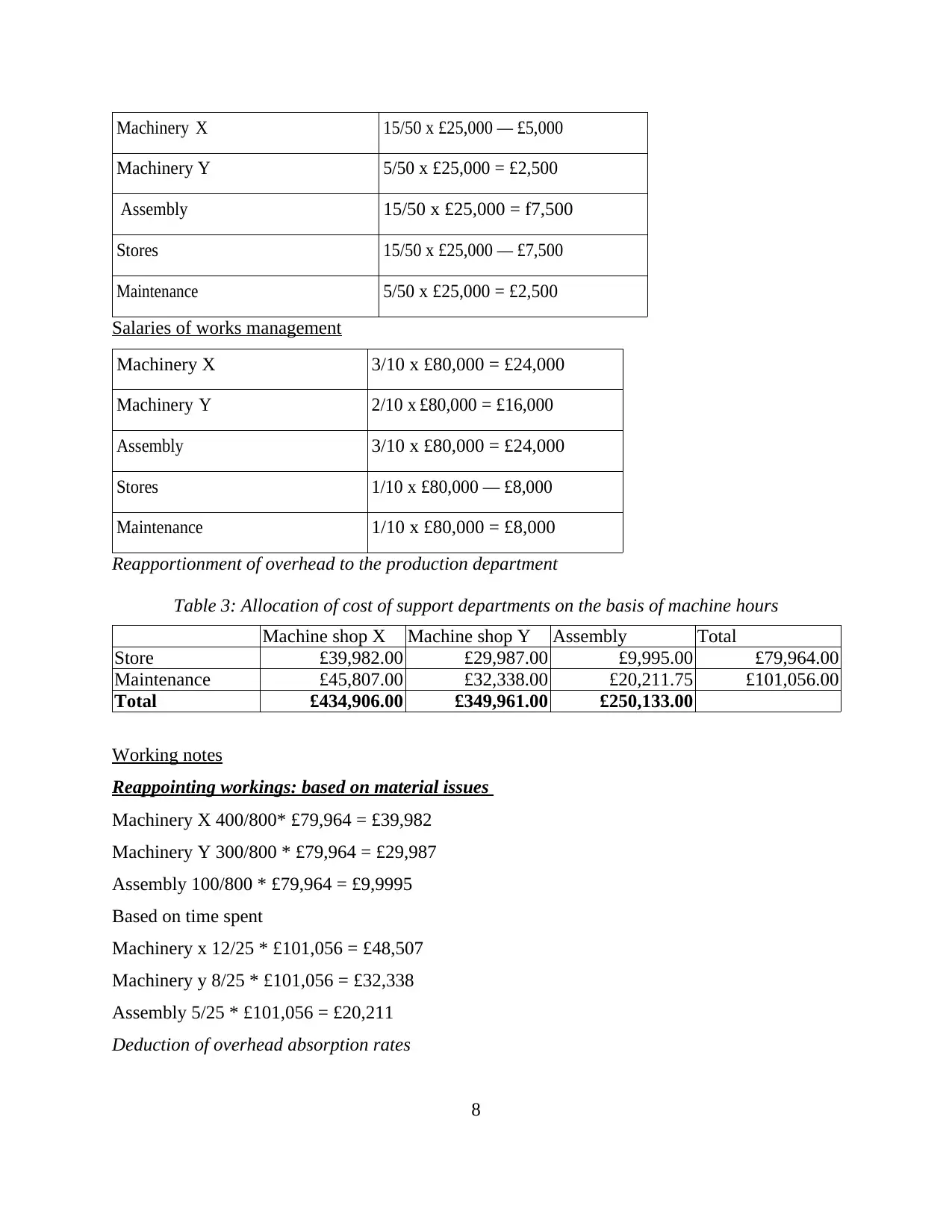
Machinery X 15/50 x £25,000 — £5,000
Machinery Y 5/50 x £25,000 = £2,500
Assembly 15/50 x £25,000 = f7,500
Stores 15/50 x £25,000 — £7,500
Maintenance 5/50 x £25,000 = £2,500
Salaries of works management
Machinery X 3/10 x £80,000 = £24,000
Machinery Y 2/10 x £80,000 = £16,000
Assembly 3/10 x £80,000 = £24,000
Stores 1/10 x £80,000 — £8,000
Maintenance 1/10 x £80,000 = £8,000
Reapportionment of overhead to the production department
Table 3: Allocation of cost of support departments on the basis of machine hours
Machine shop X Machine shop Y Assembly Total
Store £39,982.00 £29,987.00 £9,995.00 £79,964.00
Maintenance £45,807.00 £32,338.00 £20,211.75 £101,056.00
Total £434,906.00 £349,961.00 £250,133.00
Working notes
Reappointing workings: based on material issues
Machinery X 400/800* £79,964 = £39,982
Machinery Y 300/800 * £79,964 = £29,987
Assembly 100/800 * £79,964 = £9,9995
Based on time spent
Machinery x 12/25 * £101,056 = £48,507
Machinery y 8/25 * £101,056 = £32,338
Assembly 5/25 * £101,056 = £20,211
Deduction of overhead absorption rates
8
Machinery Y 5/50 x £25,000 = £2,500
Assembly 15/50 x £25,000 = f7,500
Stores 15/50 x £25,000 — £7,500
Maintenance 5/50 x £25,000 = £2,500
Salaries of works management
Machinery X 3/10 x £80,000 = £24,000
Machinery Y 2/10 x £80,000 = £16,000
Assembly 3/10 x £80,000 = £24,000
Stores 1/10 x £80,000 — £8,000
Maintenance 1/10 x £80,000 = £8,000
Reapportionment of overhead to the production department
Table 3: Allocation of cost of support departments on the basis of machine hours
Machine shop X Machine shop Y Assembly Total
Store £39,982.00 £29,987.00 £9,995.00 £79,964.00
Maintenance £45,807.00 £32,338.00 £20,211.75 £101,056.00
Total £434,906.00 £349,961.00 £250,133.00
Working notes
Reappointing workings: based on material issues
Machinery X 400/800* £79,964 = £39,982
Machinery Y 300/800 * £79,964 = £29,987
Assembly 100/800 * £79,964 = £9,9995
Based on time spent
Machinery x 12/25 * £101,056 = £48,507
Machinery y 8/25 * £101,056 = £32,338
Assembly 5/25 * £101,056 = £20,211
Deduction of overhead absorption rates
8
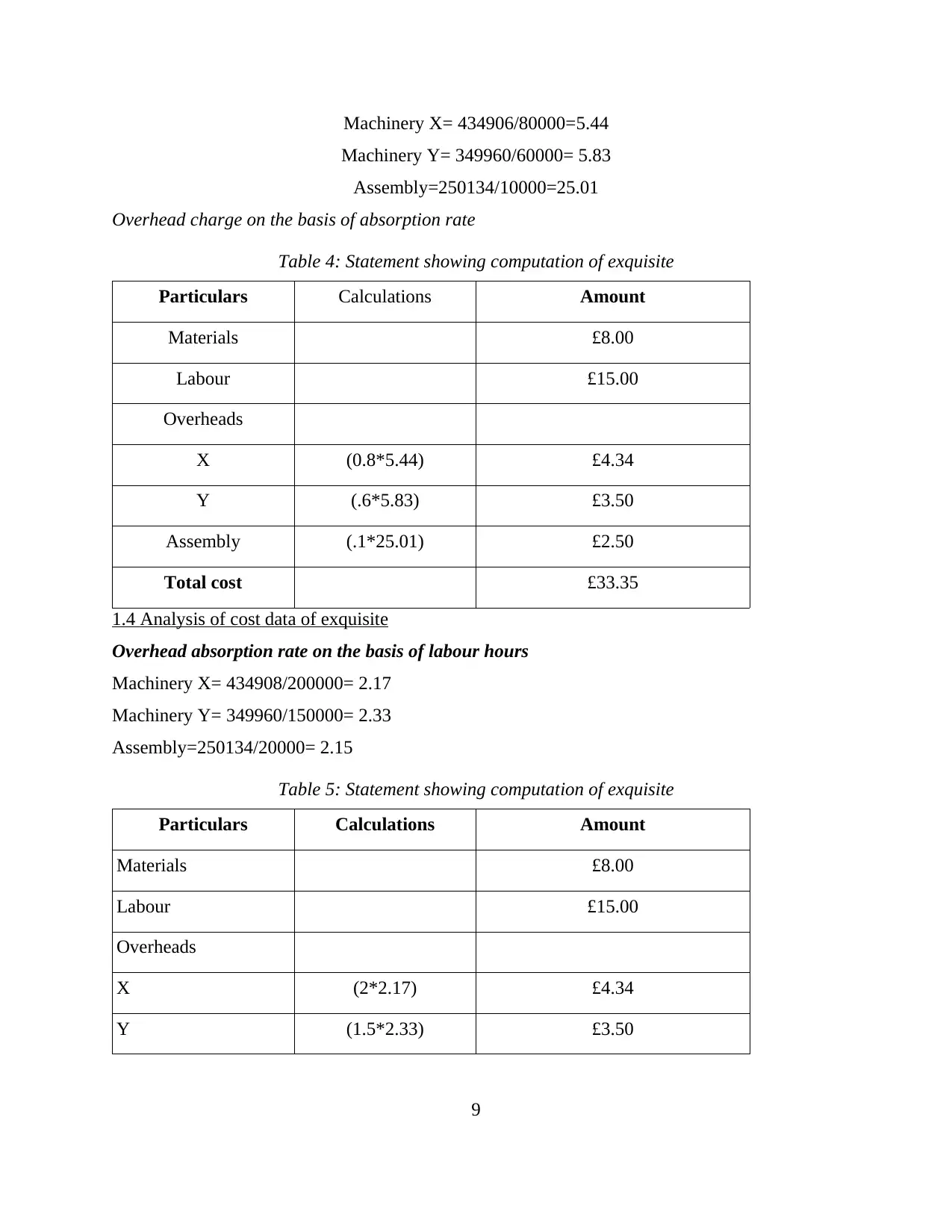
Machinery X= 434906/80000=5.44
Machinery Y= 349960/60000= 5.83
Assembly=250134/10000=25.01
Overhead charge on the basis of absorption rate
Table 4: Statement showing computation of exquisite
Particulars Calculations Amount
Materials £8.00
Labour £15.00
Overheads
X (0.8*5.44) £4.34
Y (.6*5.83) £3.50
Assembly (.1*25.01) £2.50
Total cost £33.35
1.4 Analysis of cost data of exquisite
Overhead absorption rate on the basis of labour hours
Machinery X= 434908/200000= 2.17
Machinery Y= 349960/150000= 2.33
Assembly=250134/20000= 2.15
Table 5: Statement showing computation of exquisite
Particulars Calculations Amount
Materials £8.00
Labour £15.00
Overheads
X (2*2.17) £4.34
Y (1.5*2.33) £3.50
9
Machinery Y= 349960/60000= 5.83
Assembly=250134/10000=25.01
Overhead charge on the basis of absorption rate
Table 4: Statement showing computation of exquisite
Particulars Calculations Amount
Materials £8.00
Labour £15.00
Overheads
X (0.8*5.44) £4.34
Y (.6*5.83) £3.50
Assembly (.1*25.01) £2.50
Total cost £33.35
1.4 Analysis of cost data of exquisite
Overhead absorption rate on the basis of labour hours
Machinery X= 434908/200000= 2.17
Machinery Y= 349960/150000= 2.33
Assembly=250134/20000= 2.15
Table 5: Statement showing computation of exquisite
Particulars Calculations Amount
Materials £8.00
Labour £15.00
Overheads
X (2*2.17) £4.34
Y (1.5*2.33) £3.50
9
⊘ This is a preview!⊘
Do you want full access?
Subscribe today to unlock all pages.

Trusted by 1+ million students worldwide
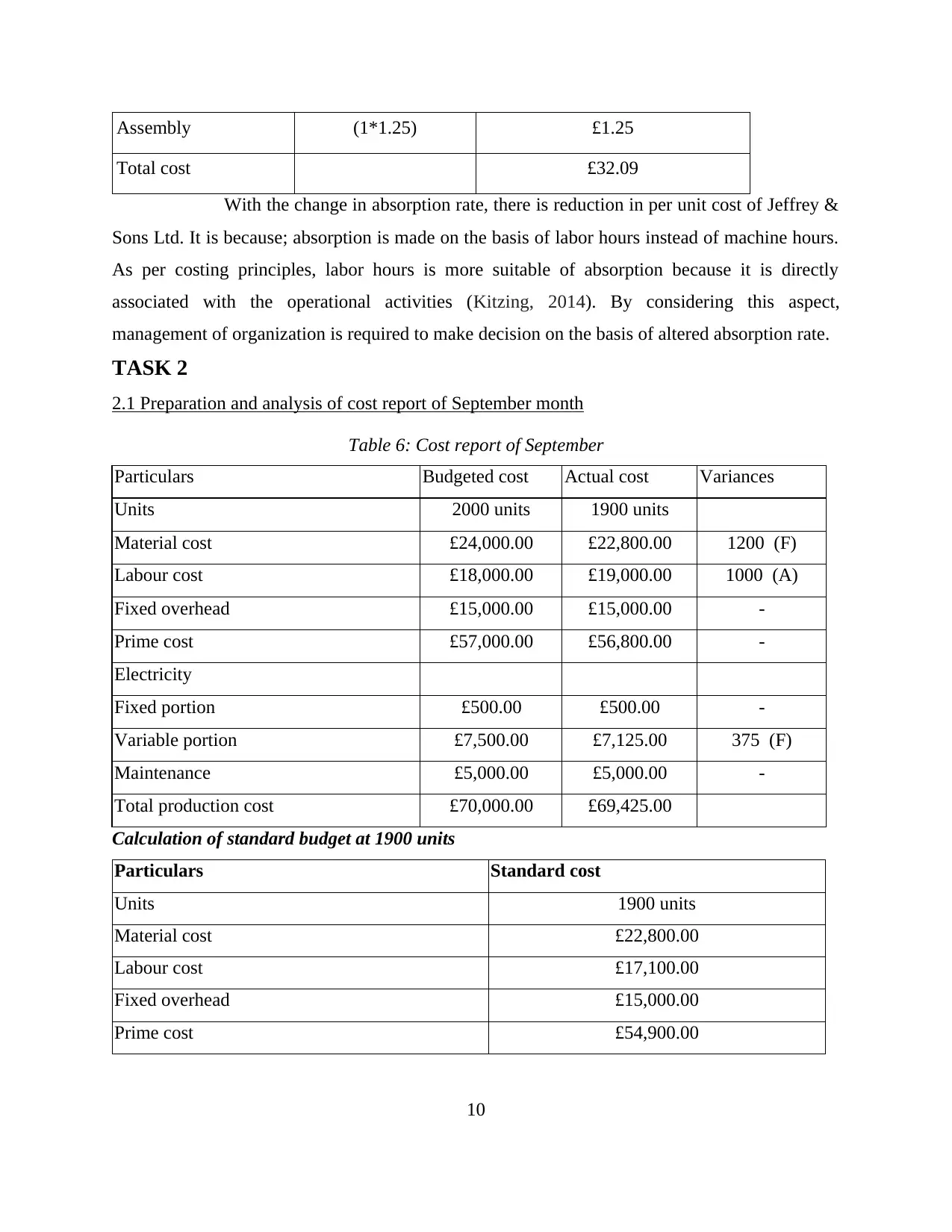
Assembly (1*1.25) £1.25
Total cost £32.09
With the change in absorption rate, there is reduction in per unit cost of Jeffrey &
Sons Ltd. It is because; absorption is made on the basis of labor hours instead of machine hours.
As per costing principles, labor hours is more suitable of absorption because it is directly
associated with the operational activities (Kitzing, 2014). By considering this aspect,
management of organization is required to make decision on the basis of altered absorption rate.
TASK 2
2.1 Preparation and analysis of cost report of September month
Table 6: Cost report of September
Particulars Budgeted cost Actual cost Variances
Units 2000 units 1900 units
Material cost £24,000.00 £22,800.00 1200 (F)
Labour cost £18,000.00 £19,000.00 1000 (A)
Fixed overhead £15,000.00 £15,000.00 -
Prime cost £57,000.00 £56,800.00 -
Electricity
Fixed portion £500.00 £500.00 -
Variable portion £7,500.00 £7,125.00 375 (F)
Maintenance £5,000.00 £5,000.00 -
Total production cost £70,000.00 £69,425.00
Calculation of standard budget at 1900 units
Particulars Standard cost
Units 1900 units
Material cost £22,800.00
Labour cost £17,100.00
Fixed overhead £15,000.00
Prime cost £54,900.00
10
Total cost £32.09
With the change in absorption rate, there is reduction in per unit cost of Jeffrey &
Sons Ltd. It is because; absorption is made on the basis of labor hours instead of machine hours.
As per costing principles, labor hours is more suitable of absorption because it is directly
associated with the operational activities (Kitzing, 2014). By considering this aspect,
management of organization is required to make decision on the basis of altered absorption rate.
TASK 2
2.1 Preparation and analysis of cost report of September month
Table 6: Cost report of September
Particulars Budgeted cost Actual cost Variances
Units 2000 units 1900 units
Material cost £24,000.00 £22,800.00 1200 (F)
Labour cost £18,000.00 £19,000.00 1000 (A)
Fixed overhead £15,000.00 £15,000.00 -
Prime cost £57,000.00 £56,800.00 -
Electricity
Fixed portion £500.00 £500.00 -
Variable portion £7,500.00 £7,125.00 375 (F)
Maintenance £5,000.00 £5,000.00 -
Total production cost £70,000.00 £69,425.00
Calculation of standard budget at 1900 units
Particulars Standard cost
Units 1900 units
Material cost £22,800.00
Labour cost £17,100.00
Fixed overhead £15,000.00
Prime cost £54,900.00
10
Paraphrase This Document
Need a fresh take? Get an instant paraphrase of this document with our AI Paraphraser
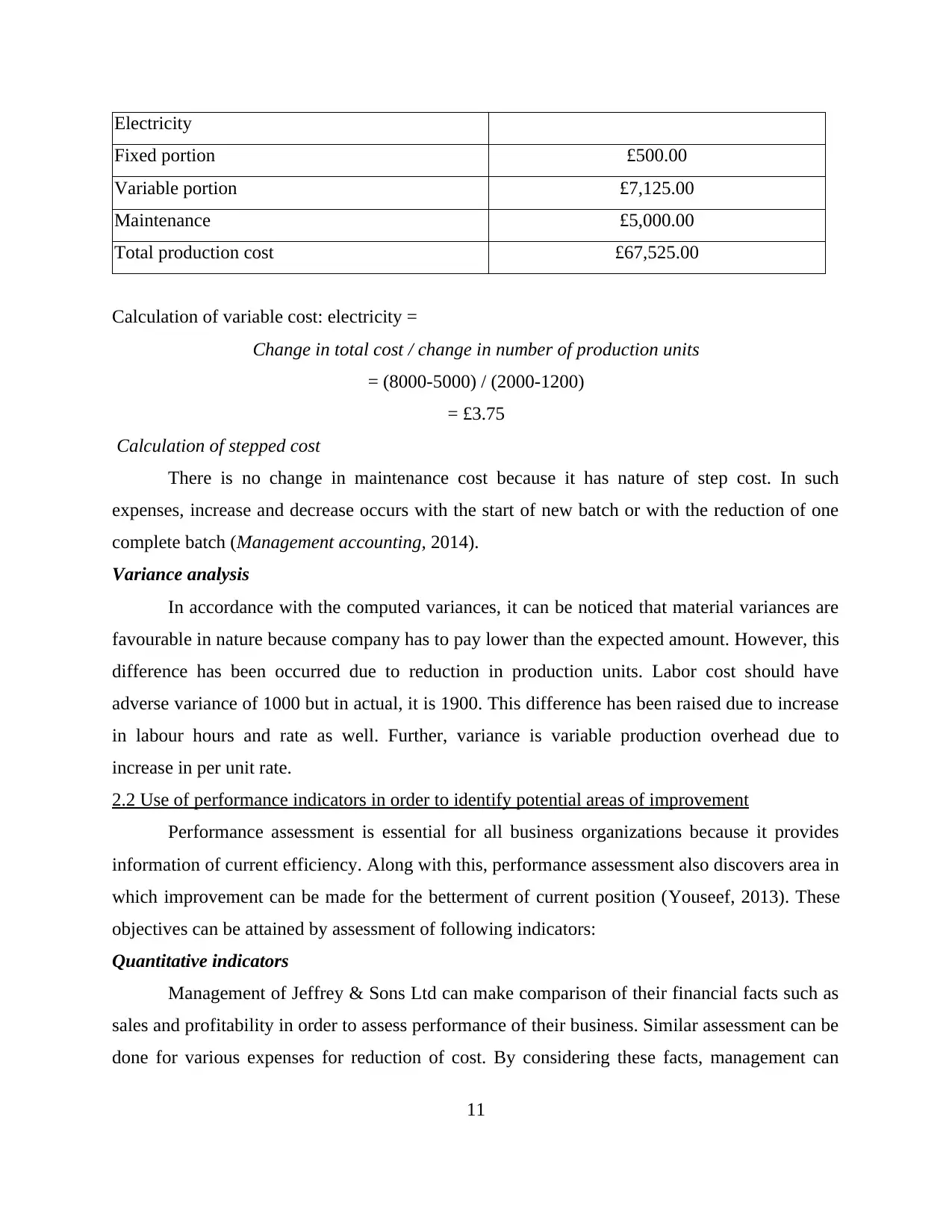
Electricity
Fixed portion £500.00
Variable portion £7,125.00
Maintenance £5,000.00
Total production cost £67,525.00
Calculation of variable cost: electricity =
Change in total cost / change in number of production units
= (8000-5000) / (2000-1200)
= £3.75
Calculation of stepped cost
There is no change in maintenance cost because it has nature of step cost. In such
expenses, increase and decrease occurs with the start of new batch or with the reduction of one
complete batch (Management accounting, 2014).
Variance analysis
In accordance with the computed variances, it can be noticed that material variances are
favourable in nature because company has to pay lower than the expected amount. However, this
difference has been occurred due to reduction in production units. Labor cost should have
adverse variance of 1000 but in actual, it is 1900. This difference has been raised due to increase
in labour hours and rate as well. Further, variance is variable production overhead due to
increase in per unit rate.
2.2 Use of performance indicators in order to identify potential areas of improvement
Performance assessment is essential for all business organizations because it provides
information of current efficiency. Along with this, performance assessment also discovers area in
which improvement can be made for the betterment of current position (Youseef, 2013). These
objectives can be attained by assessment of following indicators:
Quantitative indicators
Management of Jeffrey & Sons Ltd can make comparison of their financial facts such as
sales and profitability in order to assess performance of their business. Similar assessment can be
done for various expenses for reduction of cost. By considering these facts, management can
11
Fixed portion £500.00
Variable portion £7,125.00
Maintenance £5,000.00
Total production cost £67,525.00
Calculation of variable cost: electricity =
Change in total cost / change in number of production units
= (8000-5000) / (2000-1200)
= £3.75
Calculation of stepped cost
There is no change in maintenance cost because it has nature of step cost. In such
expenses, increase and decrease occurs with the start of new batch or with the reduction of one
complete batch (Management accounting, 2014).
Variance analysis
In accordance with the computed variances, it can be noticed that material variances are
favourable in nature because company has to pay lower than the expected amount. However, this
difference has been occurred due to reduction in production units. Labor cost should have
adverse variance of 1000 but in actual, it is 1900. This difference has been raised due to increase
in labour hours and rate as well. Further, variance is variable production overhead due to
increase in per unit rate.
2.2 Use of performance indicators in order to identify potential areas of improvement
Performance assessment is essential for all business organizations because it provides
information of current efficiency. Along with this, performance assessment also discovers area in
which improvement can be made for the betterment of current position (Youseef, 2013). These
objectives can be attained by assessment of following indicators:
Quantitative indicators
Management of Jeffrey & Sons Ltd can make comparison of their financial facts such as
sales and profitability in order to assess performance of their business. Similar assessment can be
done for various expenses for reduction of cost. By considering these facts, management can
11
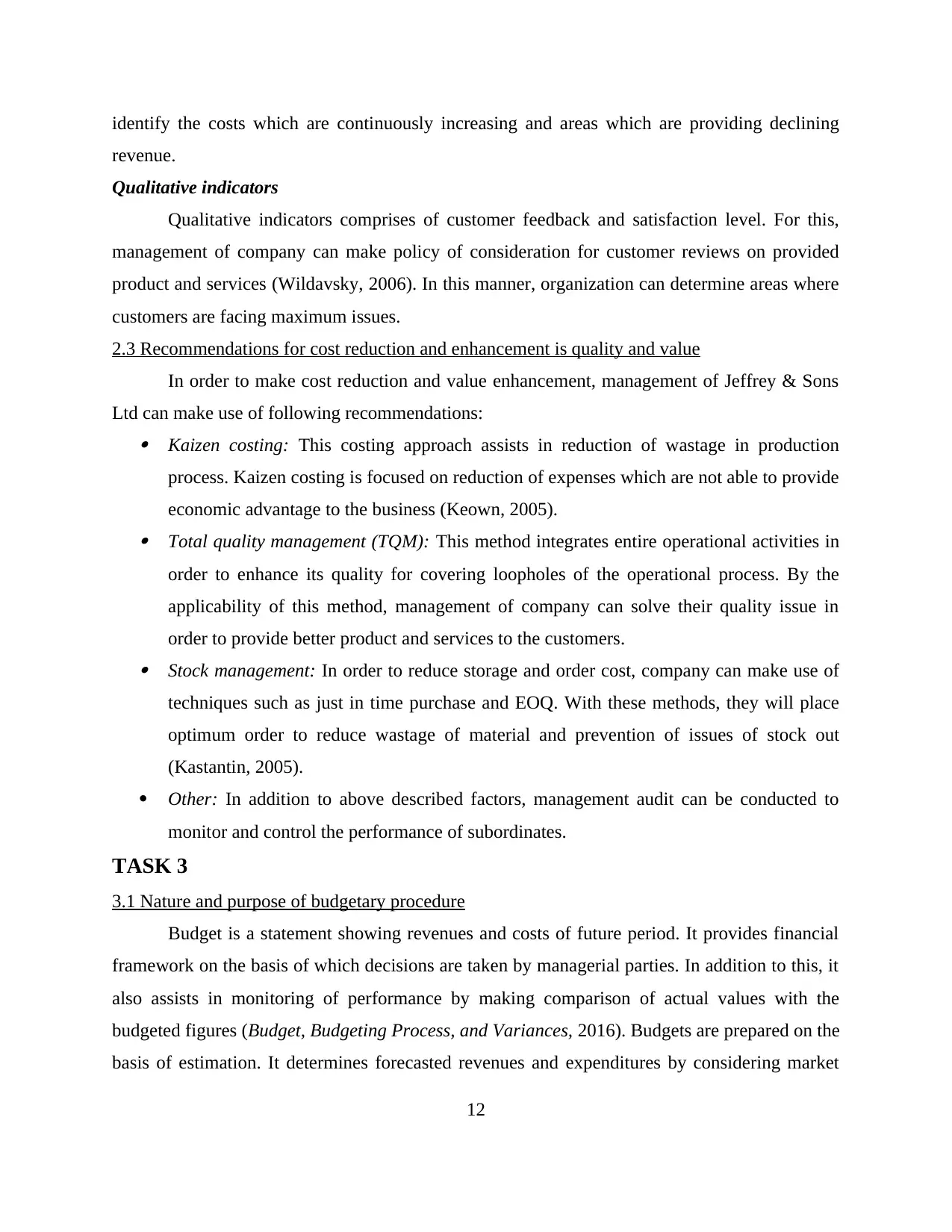
identify the costs which are continuously increasing and areas which are providing declining
revenue.
Qualitative indicators
Qualitative indicators comprises of customer feedback and satisfaction level. For this,
management of company can make policy of consideration for customer reviews on provided
product and services (Wildavsky, 2006). In this manner, organization can determine areas where
customers are facing maximum issues.
2.3 Recommendations for cost reduction and enhancement is quality and value
In order to make cost reduction and value enhancement, management of Jeffrey & Sons
Ltd can make use of following recommendations: Kaizen costing: This costing approach assists in reduction of wastage in production
process. Kaizen costing is focused on reduction of expenses which are not able to provide
economic advantage to the business (Keown, 2005). Total quality management (TQM): This method integrates entire operational activities in
order to enhance its quality for covering loopholes of the operational process. By the
applicability of this method, management of company can solve their quality issue in
order to provide better product and services to the customers. Stock management: In order to reduce storage and order cost, company can make use of
techniques such as just in time purchase and EOQ. With these methods, they will place
optimum order to reduce wastage of material and prevention of issues of stock out
(Kastantin, 2005).
Other: In addition to above described factors, management audit can be conducted to
monitor and control the performance of subordinates.
TASK 3
3.1 Nature and purpose of budgetary procedure
Budget is a statement showing revenues and costs of future period. It provides financial
framework on the basis of which decisions are taken by managerial parties. In addition to this, it
also assists in monitoring of performance by making comparison of actual values with the
budgeted figures (Budget, Budgeting Process, and Variances, 2016). Budgets are prepared on the
basis of estimation. It determines forecasted revenues and expenditures by considering market
12
revenue.
Qualitative indicators
Qualitative indicators comprises of customer feedback and satisfaction level. For this,
management of company can make policy of consideration for customer reviews on provided
product and services (Wildavsky, 2006). In this manner, organization can determine areas where
customers are facing maximum issues.
2.3 Recommendations for cost reduction and enhancement is quality and value
In order to make cost reduction and value enhancement, management of Jeffrey & Sons
Ltd can make use of following recommendations: Kaizen costing: This costing approach assists in reduction of wastage in production
process. Kaizen costing is focused on reduction of expenses which are not able to provide
economic advantage to the business (Keown, 2005). Total quality management (TQM): This method integrates entire operational activities in
order to enhance its quality for covering loopholes of the operational process. By the
applicability of this method, management of company can solve their quality issue in
order to provide better product and services to the customers. Stock management: In order to reduce storage and order cost, company can make use of
techniques such as just in time purchase and EOQ. With these methods, they will place
optimum order to reduce wastage of material and prevention of issues of stock out
(Kastantin, 2005).
Other: In addition to above described factors, management audit can be conducted to
monitor and control the performance of subordinates.
TASK 3
3.1 Nature and purpose of budgetary procedure
Budget is a statement showing revenues and costs of future period. It provides financial
framework on the basis of which decisions are taken by managerial parties. In addition to this, it
also assists in monitoring of performance by making comparison of actual values with the
budgeted figures (Budget, Budgeting Process, and Variances, 2016). Budgets are prepared on the
basis of estimation. It determines forecasted revenues and expenditures by considering market
12
⊘ This is a preview!⊘
Do you want full access?
Subscribe today to unlock all pages.

Trusted by 1+ million students worldwide
1 out of 20
Related Documents
Your All-in-One AI-Powered Toolkit for Academic Success.
+13062052269
info@desklib.com
Available 24*7 on WhatsApp / Email
![[object Object]](/_next/static/media/star-bottom.7253800d.svg)
Unlock your academic potential
Copyright © 2020–2025 A2Z Services. All Rights Reserved. Developed and managed by ZUCOL.





